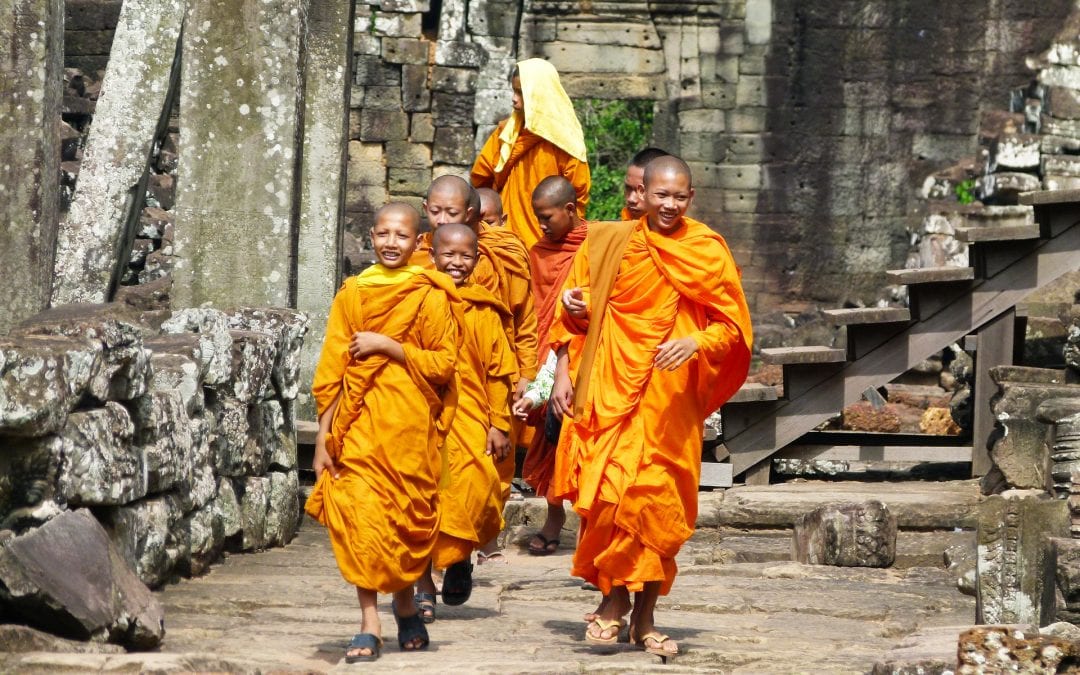Angkor Wat, located approximately 5.5 km to the north of Siem Reap, is the largest temple complex in the world and was one of the finalists for the Seven Wonders of the Modern World. In fact, the complex is so iconic that it was placed on the Cambodian flag in 1850.

Why is Angkor Wat worth visiting?
While most people already know what Angkor Wat is and generally have a good idea of what to expect prior to visiting, they are still in awe when they actually set food on the grounds of Angkor Archaeological Park. The sheer size of the architecture, the history behind the construction, and the knowledge of the fact that it was built without modern technology are all reasons that people are blown away when they take in the view of the mammoth that is Angkor Wat.
When is the best time to visit Angkor Wat?
The short answer is, as soon as possible! The number of tourists at Angkor Wat has taken a toll on the structural integrity of the site and there are already regulations put in place to restrict the number of tourists permitted at a time at certain parts of the attraction. It may not be long before they restrict tourists from visiting certain parts of the temple altogether.
If you’d like to avoid crowds as much as possible, consider visiting Siem Reap during the rainy season, which is generally June to October. During rainy days, the filled moats and ponds around Angkor Wat along with the active birdlife make it another sight to behold. Since the rain tends to start in the afternoon, you can attempt to get to the site early in the morning and see as much as possible before the rain moves in for the day.
In fact, getting to Angkor Wat early in the morning is generally a good idea, regardless of whether you go in the dry season or the rainy season. It is a great way to beat the crowd and the heat.
Approach to visiting Angkor Wat
Many people choose to go see the sunrise at Angkor Wat, where the view is spectacular. This is an option for early risers who don’t mind getting to the site before it starts getting light, get a good spot, and wait for the twilight. Sunsets are similarly spectacular, but note that there would be a lot more people for sunsets, making for a less peaceful ambiance.

Angkor Wat is an attraction that sells one-day passes, three-day passes, and even seven-day passes, so you know that is plenty to see there! As mentioned before, getting an early start is always recommended to evade both the crowds and the heat. If you’re not keen on seeing the sunrise, 7:00 a.m. is a reasonable time to get there.
A great rule of thumb is to do the opposite of what other tourists do. For example:
- Visit the other temples and leave the main temple of Angkor Wat until last. Most tourist begin with Angkor Wat first, meaning that it gets extremely busy in the morning.
- Phnom Bakheng is essentially the most popular temple at which to view to sunset. The morning or the middle of the day may be a better time to visit Bakheng. Then in the early evening, when everyone is at Bakheng, visit the other popular temples, such as Bayon and Ta Prohm (the ‘Tomb Raider Temple’).
- There are many other smaller, less known temples and areas that are just as beautiful as the popular ones, and much less crowded. Seek these out and enjoy the serenity of the park.
In terms of exploring the temples, many people find it worthwhile to hire a tour guide, who could help you avoid queues, find the nice spots, and learn interesting facts about the temples. Alternatively, you could hire a tuk tuk driver to take you around the complex, from temple to temple.
Guidelines to visiting Angkor Wat
- Angkor Wat is not lit by any artificial lighting. If you are headed there for sunrise or sunset, bring a torch (that’s flashlight for you North Americans) with you for navigation and safety while walking around the temples in the early mornings and the evenings.
- Wear light, loose-fitting clothing that covers your shoulders and knees. This is the standard dress code for visiting holy sites in Cambodia, and there are parts of the temple where it’s strictly enforced. It also serves as a nice screen for your skin from mosquitoes and the sun.
- Speaking of the sun, be vigilant in protecting yourself against its heat and harmful rays. Wear a hat, bring sunscreen, and stay hydrated.
- Wear suitable footwear, and it could be a tricky business when it comes to selecting the right kind of shoes for Angkor Wat. There are steep steps, uneven terrain around the temples, and you may end up walking for 12–15 km during your visit, so you would want something comfortable to walk in. However, some of the temples require visitors to take their shoes off before entering, so you would also want something that is also easy to take off. Sneakers and runners may get wet during rainy season, and be too hot during the dry season. Thus, many people suggest going with hiking sandals as the footwear of choice.
- Purchase your pass the day before to avoid delay on the day of the visit. The ticket office opens at 5:00 a.m., and believe it or not, the queues will already have formed by that time. Note that the ticket office for purchasing passes is not at Angkor Wat itself, but at a location on Street 60, approximately 6 km from Angkor Wat. If you buy your one-day pass after 5:00 p.m., it’s valid for the next day. Some people buy their passes after 5:00 p.m., immediately go to Angkor Wat for the sunset, then return the next day for the rest of the site.
Last but not least, use common sense and be respectful. Keep Cambodia beautiful!

